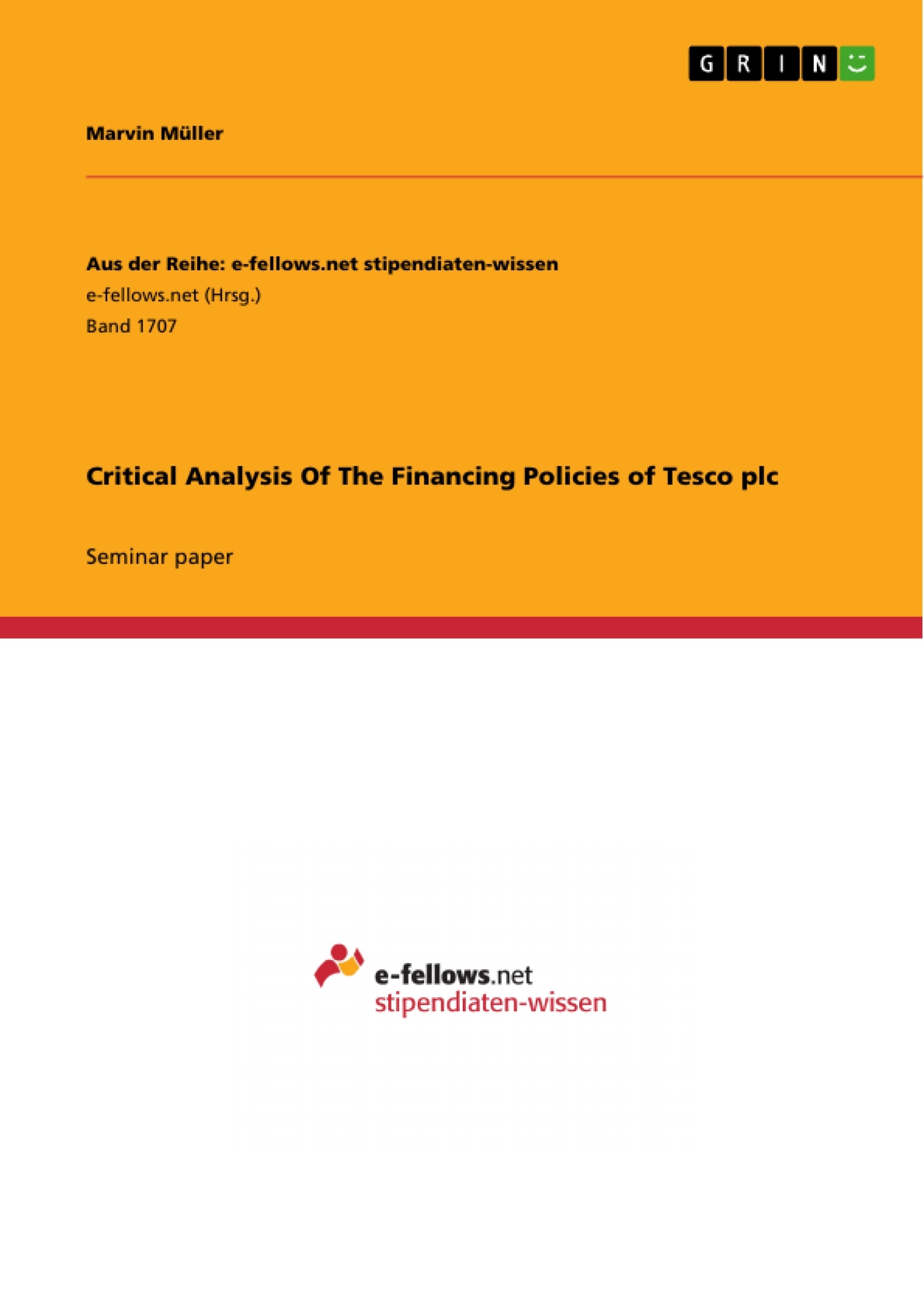The working paper aims to critically discuss Tesco's primary and secondary objectives. Moreover, the development of Tesco's gearing policy and the impact on financial figures is analysed. In a next step, literature on dividend policies is reviewed and applied to Tesco. In a last step, the capital structure policy of Tesco in respect to the pecking order and trade of theory is assessed.
Table of Contents
- 1. Critical Discussion of Tesco's Objectives
- 1.1 Primary Objective
- 1.2 Secondary Objectives
- 2. Gearing Policy
- 2.1 Development of Gearing
- 2.2 Impact on Financial Figures
- 3. Dividend Policy
- 3.1 Literature review
- 3.2 Analysis of Tesco
- 4. Capital Structure Policy
- 4.1 Pecking Order Theory
- 4.2 Trade-Off Theory
Objectives and Key Themes
This assignment critically analyzes Tesco plc's financing policies, focusing on its objectives, gearing, dividend, and capital structure strategies. The analysis aims to evaluate Tesco's success in achieving its stated goals and the impact of its financing decisions on its financial performance.
- Tesco's primary objective of maximizing shareholder satisfaction
- The development and impact of Tesco's gearing policy
- An analysis of Tesco's dividend policy and its implications
- Evaluation of Tesco's capital structure policy through the lens of Pecking Order and Trade-Off theories
- The relationship between financing decisions and Tesco's financial performance indicators.
Chapter Summaries
1. Critical Discussion of Tesco's Objectives: This chapter examines Tesco's corporate objectives, primarily focusing on shareholder satisfaction as measured by share price and dividend payouts. The analysis reveals a decline in share price, indicating dissatisfaction, despite growth in dividends until 2015. The contrasting trends in share price and dividend highlight the complexities of maximizing shareholder value and the limitations of using these metrics alone to gauge overall success. The chapter uses Tesco's 2010-2015 performance data (including a graph showing share price development) as evidence. The significant drop in share price and the decrease in dividends in 2015 suggest Tesco fell short of its primary objective during this period.
Keywords
Tesco plc, financing policies, shareholder satisfaction, gearing policy, dividend policy, capital structure, Pecking Order Theory, Trade-Off Theory, share price, dividends, Return on Shareholder Funds (ROSF), financial performance.
Tesco plc Financing Policies: A Critical Analysis - FAQ
What is the main topic of this document?
This document is a comprehensive preview of an academic assignment critically analyzing Tesco plc's financing policies. It covers Tesco's objectives, gearing policy, dividend policy, and capital structure strategy, evaluating their impact on financial performance.
What are the key themes explored in the analysis?
The key themes include Tesco's primary objective of maximizing shareholder satisfaction, the development and impact of its gearing policy, an analysis of its dividend policy, an evaluation of its capital structure policy using Pecking Order and Trade-Off theories, and the relationship between financing decisions and Tesco's financial performance indicators.
What specific aspects of Tesco's financing are analyzed?
The analysis focuses on four main aspects: Tesco's stated objectives (particularly shareholder satisfaction), its gearing policy (including its development and impact on financial figures), its dividend policy (with a literature review and specific analysis of Tesco's practices), and its capital structure policy (evaluated through the lens of established theories like the Pecking Order and Trade-Off theories).
What data is used in the analysis?
The analysis utilizes Tesco's performance data from 2010-2015, including a graph illustrating share price development. This data is used to assess the success of Tesco's objectives and the impact of its financial decisions.
What theories are applied to analyze Tesco's capital structure?
The Pecking Order Theory and the Trade-Off Theory are applied to analyze and evaluate Tesco's capital structure policy and its effectiveness.
What are Tesco's primary objectives, and how successfully were they achieved (based on the preview)?
Tesco's primary objective is maximizing shareholder satisfaction. The preview suggests mixed results. While dividends increased until 2015, share price showed a decline, indicating potential shortcomings in achieving this primary objective, especially after 2015.
What are the key findings or conclusions suggested in the preview?
The preview highlights the complexities of maximizing shareholder value using solely share price and dividend payouts. The contrasting trends in share price and dividends demonstrate the limitations of using these metrics alone to judge overall success. The significant drop in share price and dividends in 2015 suggests a period where Tesco fell short of its primary objective.
What are the key words associated with this analysis?
Tesco plc, financing policies, shareholder satisfaction, gearing policy, dividend policy, capital structure, Pecking Order Theory, Trade-Off Theory, share price, dividends, Return on Shareholder Funds (ROSF), financial performance.
What is included in the Table of Contents?
The table of contents outlines the structure of the full assignment, covering a critical discussion of Tesco's objectives, its gearing policy, dividend policy, and capital structure policy, with specific sub-sections for each topic.
What type of document is this?
This is a preview of an academic assignment, providing a structured overview of its content, objectives, and key findings for academic use. It is not a complete analysis itself.
- Quote paper
- Marvin Müller (Author), 2015, Critical Analysis Of The Financing Policies of Tesco plc, Munich, GRIN Verlag, https://www.grin.com/document/315138




